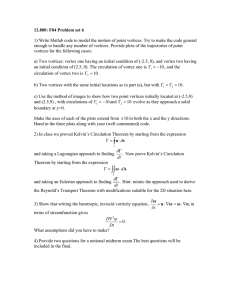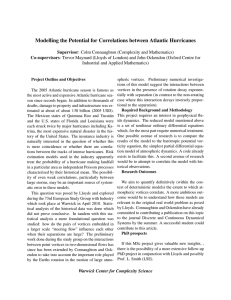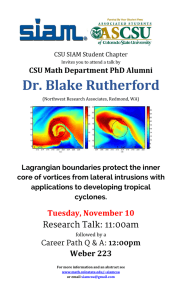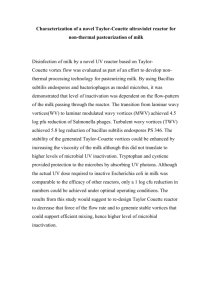Passage of Abrikosov Vortexes through a Boundary Barrier in Thin
advertisement
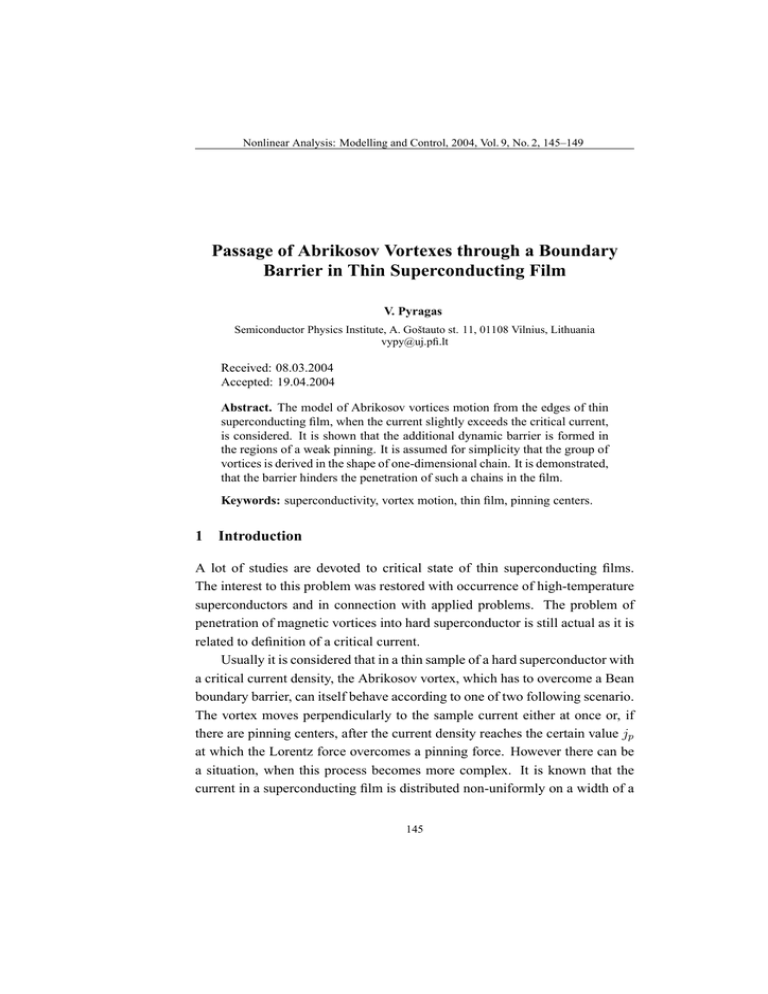
Nonlinear Analysis: Modelling and Control, 2004, Vol. 9, No. 2, 145–149 Passage of Abrikosov Vortexes through a Boundary Barrier in Thin Superconducting Film V. Pyragas Semiconductor Physics Institute, A. Goštauto st. 11, 01108 Vilnius, Lithuania vypy@uj.pfi.lt Received: 08.03.2004 Accepted: 19.04.2004 Abstract. The model of Abrikosov vortices motion from the edges of thin superconducting film, when the current slightly exceeds the critical current, is considered. It is shown that the additional dynamic barrier is formed in the regions of a weak pinning. It is assumed for simplicity that the group of vortices is derived in the shape of one-dimensional chain. It is demonstrated, that the barrier hinders the penetration of such a chains in the film. Keywords: superconductivity, vortex motion, thin film, pinning centers. 1 Introduction A lot of studies are devoted to critical state of thin superconducting films. The interest to this problem was restored with occurrence of high-temperature superconductors and in connection with applied problems. The problem of penetration of magnetic vortices into hard superconductor is still actual as it is related to definition of a critical current. Usually it is considered that in a thin sample of a hard superconductor with a critical current density, the Abrikosov vortex, which has to overcome a Bean boundary barrier, can itself behave according to one of two following scenario. The vortex moves perpendicularly to the sample current either at once or, if there are pinning centers, after the current density reaches the certain value jp at which the Lorentz force overcomes a pinning force. However there can be a situation, when this process becomes more complex. It is known that the current in a superconducting film is distributed non-uniformly on a width of a 145 V. Pyragas film. It has a maximal value on the edges and decreases towards the middle of the film [1]. Let’s assume that somewhere at the edges the current density has slightly exceeded jp , but in other places – still not. Then the vortices in this area should begin a dissipative motion, and the resistance occurs in the sample. This situation is not energetically favorable, therefore the current bypass this area and superconductivity is conserved. Therefore near edges of a superconductor there will be an area of vortices from which the current is pushed out. Two forces will operate in this situation. The Lorentz force between the current and vortices pulls the vortices inside the sample. On the other hand, the redistribution of the current changes the energy of a magnetic field, and therefore the force will arise expelling this area from the sample. The balance of these forces creates the conditions for a separation of area of vortices from edges and subsequent dissipative motion crosswise the sample. 2 Model and solution Let’s assume, that the sample of a hard superconductor has length, width and thickness in the ratio: l b d, and the current J flows along the sample. Our coordinates are guided along length (X-axis), width (Y -axis) and thickness (Z-axis) of the sample. Then for a thin sample λ > d, where λ is the Londons penetration depth, we can write the Londons equation [1]: λef dj 2π +2 b dy Z1 j(y 0 )dy 0 + n(y)Φ0 = 0, y0 − y (1) −1 here y = Y /b is a dimensionless coordinate, λef = λ2 /d is an effective penetration depth in a thin sample, j is a current density integrated with respect Rb to the thickness of the sample (complete current J = j(y)dy), Φ0 = π~c/e 0 is an elementary magnetic flux and n(y) is the density of vortices. For a hard superconductor we assume that the magnetic field, when the current density is sufficient for formation of a mixed state, will enter in the form of vortices. If the magnetic field, caused by a current near the edges of a sample, is less than Hc1 , the sample will be in the Meysner state with distribution of a current far 146 Passage of Abrikosov Vortexes through a Boundary Barrier from the edges j(y) = 2J (1 − y 2 )−1/2 . πb (2) Here we consider that the middle of the sample is y = 0. The divergences at the edges are related to accepted approaches and usually are eliminated by equating j to any constant value near the edges of the sample with a requirement of maintaining of a complete current (see eg. [2]). At the edges of the sample the magnetic field also has the largest values only of opposite signs [3]: Hz0 (y) 2d = c Z1 j(y 0 )(y − y 0 )dy 0 . (y − y 0 )2 + z 2 (3) 0 With increase of current, the magnetic field at the edges exceeds the magnitude necessary for overcoming of the Bean barrier, Hs > Hc1 , and vortices will penetrate the sample. If there are no pinning forces, the vortices under the action of Lorentz force will move across the current with a dissipation, and the superconductor will transfer to a resistive state at once. However in real structures the vortices are restrained by the pinning centers, and the superconductivity is maintained, until the current density does not reach a certain value jp necessary for overcoming the pinning forces. We assume that in some area near the edges, where the pinning forces are weaker, the vortices have penetrated into a sample and created the area of normal conductance. We assume, that the vortices will permeate as onedimensional chain of length h. Then the difference of magnetic energies in the sample with and without chain of vortices is: 1 ∆E = 8π Z∞ −∞ dx Z1 λef /b 1 2 (Hz ) − (Hz0 )2 dy. (4) To find the distribution of a current after occurrence of a chain of vortices, we represent a plane x, y as a complex plane z = x + iy and make its conformal representation on a plane w = u + iv in such a way that the segment (0, h) has been substituted to a segment (h,0). Such transformation is performed by the 147 V. Pyragas function: π πh2 cth z. (5) 4b2 2 After this transformation the current distribution in the plane u, v is analogous to (2), and for ∆E we obtain: w=z+ Z∞ bJ 2 ∆E = 2 πc −∞ dx Z1 1 1 − dy, v(1 − v) y(1 − y) (6) λef /b where −1 π πh2 π 2π 2π . (7) v = y − 2 ctg y · sh x + tg y · ch x 4b 2 2 2 2 Then the force expelling chain of vortices from the sample will be equal to a gradient with respect to the difference between the magnetic field energies. Then Fout = π 3 J 2 h2 · (1 + h2 /2λ2ef )−1/2 · 8c2 λ2ef (8) at h/b 1. Let’s determine the Lorentz force which operates between vortices area and the current. Magnetic field generated by one vortex at distance y from its core is [4]: hz = Φ0 K0 (y/λ)/2πλ2 , (9) where K0 (z) is the Bessel function. The interaction force between one vortex and a current of a sample is equal b fi = c Z1 j(y)hiz dy. (10) yi In order to get the summary Lorentz force, we have to sum fi over all the chain with the density of vortices in the chain 1 n= hΦ0 Zh (Hz1 − Hs )dy. (11) 0 148 Passage of Abrikosov Vortexes through a Boundary Barrier Then for nλ 1 the chain of vortices of length h will interact with a current with a force Fl ≈ (πλ/2b)1/2 Φ0 J exp(−1/nλ). cπ 2 hλ (12) At h ∼ λef the force Fout exceeds Fl and increase proportionally to h2 . Thus, the expelling force exceeds Lorentz force, and we can conclude that the vortices will not penetrate through the edge of a sample as one-dimensional chains. In [5] the penetration problem of a group of vortices as two-dimensional bundles was solved. It was shown, that the size of vortices area, necessary for the group to penetrate the edges, depends on the difference between the current in the sample and the critical current. References 1. Kupriyanov M.Yu., Likharev K.K. “O vliyanii kraevogo bar’era na kriticheskii tok sverkhprovodyaschei plenki”, FTT, 16(10), p. 2829–2833, 1974 2. Vendik O.G., Popov A.Yu. “Raspredelenie toka v poperechnom sechenii i pogonnoe soprotivlenie sverkhprovodyaschei mikropoloskovoi linii”, ZhTF, 63(7), p. 1–9, 1993 3. Rhoderic E.H., Wilson E.M. “Current distribution in thin superconducting films”, Nature, 194, p. 1167–1168, 1962 4. Van Duser T., Turner C.W. Principles of superconductive devices and circuts, Elsevier North Holland, 1981 5. Pyragas V., Balevicius S., Kiprijanovicius S., Jukna A. “Electric current indused magnetic flux penetration into the superconducting film”, in: Vakuumnaya technologiya i osnastka. Materialy mezhdunarodnoi konferencii, Panevezhis, Litva, 29–30 okt., 1998 149
